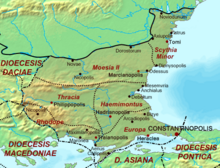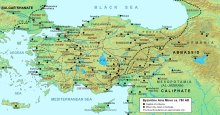Thrace (Byzantine theme)
The theme Thrace ( Greek θέμα Θρᾴκης / theme THRAKIS or Greek θέμα Θρᾳκῷον / theme Thrakon was) a military-administrative management unit in the Byzantine Empire ( theme ), in the southeast of the Balkan peninsula , in the 7th century, the reign of the Byzantine Emperor during Heraclius justified has been. It stretched over part of the historical landscape of the same name, Thrace, and had different dimensions throughout history. The area encompasses today's southeastern Bulgaria and the neighboring region of European Turkey ( Eastern Thrace ). The region belonged to the immediate hinterland of Constantinople.
The Thrace theme existed from around 680 to 1204 and then again from the 1230s to the 14th century. The topic 680/681 was founded. The re-establishment of the theme in the 1230s was related to the recovery and expansion of the Nikaia Empire . In the 14th century the topic was then divided into smaller administrative units.
The territory of the Thrace theme roughly encompassed, albeit somewhat enlarged, the pre-existing Roman late antique province of Europe. In contrast, the late antique province of Thracia, after the imperial reform of Emperor Diocletian (ruled 284–305), was further to the northwest.
The capital was Adrianopolis (today Edirne ) and later Arcadiopolis (today Lüleburgaz ).
history
It is widely believed that the Thrace theme was founded around 680 as a simple military command in response to the threat posed by the Bulgarians . At that time it was mainly a military administrative unit of a higher military command. This assumption is based on the report of a certain Patrikios Theodoros, Comes on the subject of Opsikion and Hypostrategos of Thrace, in the years 680/681.
The mention, however, does not allow to establish with certainty whether Thrace existed as a separate military command. So it remains unclear whether Theodoros acted as the holder of a military double post - Thrace was an independent topic - or whether Thrace was only an administrative sub-unit of the Opsikion topic. In any case, a separate strategos from Thrace to 742 is not clearly mentioned in the sources. Seals of strategists exist only from the 8th century. Initially, Adrianople was certainly the subject's capital.
Under Empress Irene , the subject was split in the late 8th century. The western part became the independent topic of Macedonia . From then on, Arcadiopolis was the capital of the Thrace theme.
Administrative sub-units of the topic were the tourmai (singular: Tourma ; Greek: τούρμα), under one tourmarches each , in Bizye (today vice ) and Sozopolis (today Sozopol ). There is also a third command, the tourmarches tes Thrakes (" Tourmarches of Thrace"), it was probably Arcadiopolis and was subordinate to the deputy of the strategos .
In the 9th and 10th centuries, the Arab geographers Ibn Chordadhbeh (* around 820, † around 912) and Ibn al-Faqih mentioned the subject, which extends “from the long wall [the Anastasius Wall ] to the subject of Macedonia, and after North to the land of the Bulgarians, with 10 fortresses and 5,000 troops. ”These 5,000 soldiers had to provide the topic when the Byzantine Empire was at war. Thrace provided many archers and lancers.
The borders of the Thrace theme changed course on the northern border of the Byzantine Empire during the Byzantine-Bulgarian wars . Initially, the topic must have included most of the ancient diocese of Thrace ("Dioecesis Thraciae" / Greek Διοίκησις Θράκης; dĭœcēsĭs; see: late ancient province of Thrace ), except for the country along the Danube, which was overrun by the Bulgarians. But after the conquests of Krum (ruled 803-814), Omurtag (ruled 814-831) and Simeon I (ruled 893-927), the border was gradually shifted to the area south of the Balkan Mountains, roughly to the line that also took the forms today's border between Bulgaria and its southern neighbors Greece and Turkey. At the turn of the 10th century, the topic then essentially comprised the eastern half of what is today part of European Turkey ( Eastern Thrace ). However, it stretched far north along the Black Sea coast , including Anchialos, today's Pomorie .
During the 10th century, Thrace ranked ninth among the 30 Byzantine themes in terms of economic importance. From the 11th century onwards, the areas of Thrace and Macedonia are usually only mentioned together, which indicates that they were combined. This is attested by documents from numerous strategists and from judges ( Kritai ) who sat in court on both subjects.
After the storming of Constantinople in 1204, Thrace was incorporated into the Latin Empire by the Crusaders , but was recaptured by the Byzantines in the first half of the 13th century. After that it was no longer an issue.
During the last Byzantine imperial dynasty, the time of Palaiologoi (1259-1453) came the name issue Thrace as an administrative designation disuse. However, it was still used as an obsolete term by some contemporary historians.
With the conquest of Constantinople by the Ottomans in 1453 , the administration of the Byzantine themes finally came to a standstill.
literature
- John F. Haldon: Byzantium in the Seventh Century: The Transformation of a Culture. Cambridge University Press, Cambridge 1997, ISBN 978-0-521-31917-1 . ( at google books )
- Alexander Petrovich Kazhdan (Ed.): The Oxford Dictionary of Byzantium. Oxford University Press, New York / Oxford 1991, ISBN 978-0-19-504652-6 .
- John W. Nesbitt, Nicolas Oikonomides (Ed.): Catalog of Byzantine Seals at Dumbarton Oaks and in the Fogg Museum of Art. Volume 1: Italy, North of the Balkans, North of the Black Sea. Dumbarton Oaks Research Library and Collection, Washington 1991, ISBN 0-88402-194-7 .
- A. Pertusi: Constantino Porfirogenito: De Thematibus. Biblioteca Apostolica Vaticana, Rome 1952.
Individual evidence
- ^ Haldon: Byzantium in the Seventh Century: The Transformation of a Culture. 1997, p. 216.
- ^ A b Nesbitt, Oikonomides: Catalog of Byzantine Seals at Dumbarton Oaks and in the Fogg Museum of Art. 1991, p. 155.
- ↑ a b Pertusi: Constantino Porfirogenito: De Thematibus. 1952, p. 156.
- ↑ Kazhdan: The Oxford Dictionary of Byzantium. 1991, pp. 2079-2080.
- ↑ Pertusi: Constantino Porfirogenito: De Thematibus. 1952, p. 157.
- ↑ Pertusi: Constantino Porfirogenito: De Thematibus. 1952, pp. 157-158.
- ↑ Kazhdan: The Oxford Dictionary of Byzantium. 1991, p. 2080.



